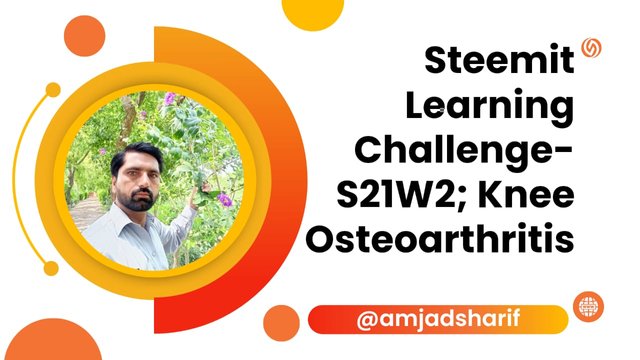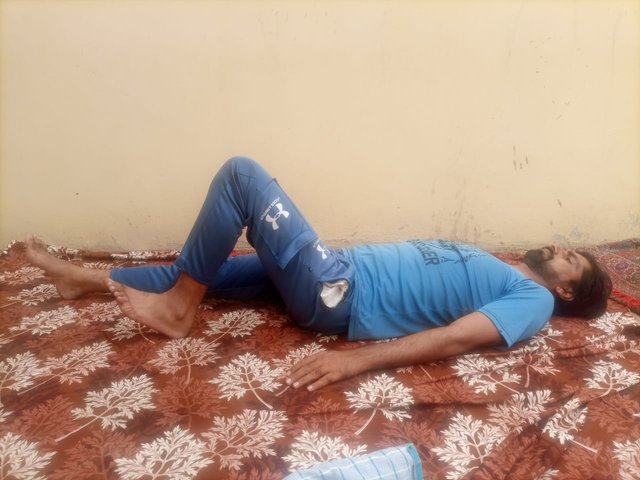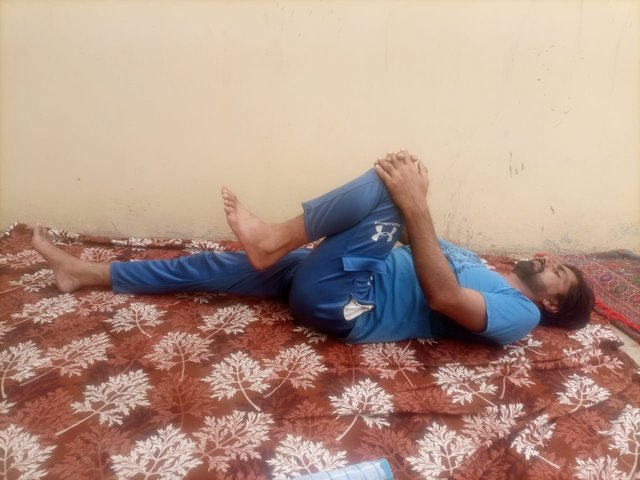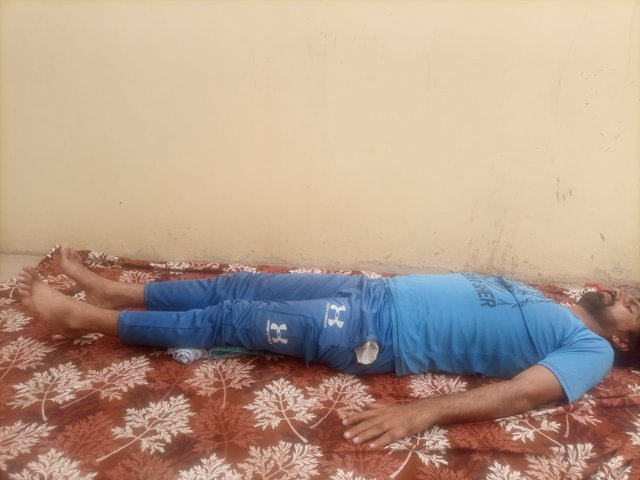Steemit Learning Challenge-S21W2; Knee Osteoarthritis
AssalamuAlaikum & Greetings Everyone!
AssalamuAlaikum & Greetings Everyone!
I am glad to see that the first week has ended and we are in 2nd week of the season 21, thanks teacher @ashkhan for this wonderful lecture on Knee Osteoarthritis.

Q.1 - What's knee OA? Write in your own words after getting knowledge from the lesson post.
Knee Osteoarthritis or Knee arthritis is a joint disease that occurs commonly with increasing age. In this disease, the walls of the knee joint and a special tissue, joint cartilage, erode and rub through. Lack of cartilage leads to rubbing of bones, which will lead to pain and discomfort during walking standing, sitting, and other activities.
Causes of Disease
This condition has a host of causes generally referred to as osteoarthritis of the knee. This is especially true in the youthful generations because cartilage gradually degenerates with age This is especially makes a lot of sense, especially with youngsters because we all know that cartilage starts to wear out as one age. Secondly, the problem of being overweight aggravates the stressed load on the knee joint, and cartilage damages it. Their findings also used to also support the fact that people with a family history of diseases are also likely to be affected by the diseases. Each of these with other factors such as previous knee surgery and injuries causes the condition to become worse in some individuals.
Symptoms of the Disease
Signs of knee osteoarthritis are pain at the knee joint, stiffness of the knee, swelling of the joint, and limited range of motion. Knees ought to ache in the morning and when one has been seated for a long time. However, it also can be the noise of walking at night, that indicates this disease. It progresses and over time the symptoms make it almost impossible for a person to be active.
Treatment and Precautions
Although osteoarthritis of the knee can be managed conservatively, it can also be treated in the following manners. In the early stages of the condition, certain movements, exercises, physiotherapy, and keeping the knee off might be beneficial. Proper dieting is also said to be crucial in order not to add any more pressure on the knees. These top doctors may also recommend certain drugs to help in the alleviation of pain. In some conditions, if the condition has gone out of hand and the patient is at high risk, then surgery can be carried out.
Useful Tips for Living
Knee OA does limit some activities but life doesn’t have to be burdensome. Many of these suggestions are communicated orally or in writing by the patient or a carer during a home visit or clinic visit. For instance, take foods rich in calcium and vitamin D to maintain strong bone density. Yoga and swimming are fine exercises as they assist in the development of the knee muscles. Further, it might help to wear comfortable shoes and a knee support belt or to wear something that supports the knee.
It worsens with time but with due diligence and ensure adherence to the necessary medical procedures, life can be made exciting.
Q.2 - How would you diagnose a knee OA? Any clinical investigation or assessment tests?
This paper focuses on the diagnosis and screening of knee OA so that timely intervention may be taken. The next thing is where is knee OA diagnosed and what clinical test assists.
First Sign and Physiological Background
The most common method of diagnosing knee OA requires the doctor to outline the patient’s symptoms. Physicians start for example with questions about each patient’s medical history – do they have knee pain, is there stiffness, swelling or even reduced range of motion? Alternatively, also observe whether pain is aggravated at morning or aggravated at mid or end of the day. Further, the pain or stiffness is evaluated about each thing a patient does daily, to identify how it impacts their lives.
Physical Examination
A medical history, is then succeeded by physical examination. Doctors pay attention to the knee’s ability to move and its flexibility, and sounds produced as the knee is manipulated such as a click. Oedema and erythema around the knee is also present. This gives the doctor an idea of the condition of the knee joint and how much damage has been caused to this joint.
X-Rays
X-ray is the most basic and standard technique used in diagnosing. X-rays explain the gap between the bones of knee joint. In OA, this distance is different as the cartilage – the soft smooth area of the joints – deteriorates. The bones also may grow at the ends or get out of their position completely and this is a hallmark of OA.
MRI
If this information is required an MRI may also be done though an X-ray is often adequate. It can also make out the structures that are not as hard as bone such as cartilage, ligaments and tendons of the knee joint. MRI is more sensitive than CT and assists in determining injury to soft tissues other than bone.
Blood Tests
Blood tests do not diagnose OA but they might inform that someone has either Rheumatoid arthritis or not. If the swelling is too high and the joint pain stays around, blood can also be drawn and tested for infections or other inflammation.
Joint Fluid Analysis
At times, doctors also remove a bit of the synovial fluid for analysis while performing a procedure called arthrocentesis. This fluid points to the fact that there is no infection or any other inflammatory disease of the joint.
Specific Scoring System
Still, there are also different scoring systems measuring the extent of OA, for instance the “Kelgreen and Lawrence scale”. This puts a level to the severity of the OA to enable effectively treat the condition.
Q.3 - Try to practice at least 4 exercises that you have learned from the lesson. Share images, gifs or videos while practising.
- As a warm up exercise engage on Heel Slides as this is perfect in activating the knees muscles. In this you slow flex the knee and then extend pulling the heel to the ground. This movement enhance the flexibility and the flexibility of the knee cap.
- William Flexion or Knee to Chest is an exercise of pulling the knee to the chest. This eases pain in the back, on the knees, and builds up muscles. In this you slowly pull one knee towards the chest and then let it back down to the floor.
- Knee Isometrics also known as Knee Flexion exercises is a position where the knee cannot be locked but has to be set at a specific angle. The basis of this exercise is the strength in the knee muscles and joints should be built up.
- The Calf & Hamstring Stretch is an exercise in which you pull your calf in addition to your hamstring, therefore making your legs more flexible. In this you assume a straight sitting or standing position, and then you move your legs forward, an action which massages the calf and thigh muscles.
All of these are basic exercises and help in strengthening and flexibility of knee joints.
Q.4 - Share your review after performing these exercises either on healthy individual or patient.
As observed in different knee and leg complaints, particularly condition like osteo arthritis, ‘heel slide’, ‘knee to chest’, ‘knee flexion’, ‘hip abuduction and adduction’ and ‘calf and hamstring stretches’ may prove extremely beneficial. I have done an experimental survey of these exercises and the results that have been obtained are proof of the fact that these exercises are very useful in developing leg muscles, increasing flexibility and thus enhancing the physical stability of any person’s body.
1. Heel Slides

The exercise is highly beneficial to those with knee issues. So with this kind of exercise as ‘heel slides,’ the knee can be manipulated to flex either backward or forward thus stretching the knee joints thereby minimizing stiffness in the knees. It is useful in enhancing knee muscles and as well enhances the flexibility of the muscles around the knees.
2. William Flexion ( Knee to Chest Exercise)

It is strongly recommended with a view of helping to minimize back and leg discomforts. “Knee-to-chest” exercise is an effective in achieving a particular stretch that would relax muscles in the legs and back as well as help in attaining more movement flexibility in the body. It also helps to stretch the knee joint very well, in order to make it more or even more mobile.
3. Knee Isometrics ( Knee Flexion )

Knee flexion exercises are also very convenient for increasing knee range of motion and stiffness. It enhances craft in the knees and firmness of the joints muscles and enhances mobility and flexibility. Osteoarthritis patients who have problems with the joint mobility find Gyroscopic therapy especially useful.
4. Knee Isometrics ( Hip abduction & adduction)
These exercises help to tone up the muscles of the hip and also help strengthen hip joint. Flexor and abductor exercises include “hip abduction and adduction” assisting in supporting muscles of the hip and body balance. It allows movement in the legs as well as the entire body.
5. Calf and Hamstring Stretch
.jpeg)
It is also know as the Muscle Rear Option or The chair.
They both exercises are essentially for the legs and especially focused on the ability of the calf and hamstring muscles. A “calf and hamstring stretch” relieves cramps, Listing exercise that provides an added benefit of enhancing circulation in the lower limbs. The following exercise also assists in prevention of knee and leg strengthening.
In particular, these exercises enhance the quality of movement and flexibility of joints and are beneficial for the patients with osteoarthritis. All these facilitate free joint movements, combats stress and develops the muscles.
I am inviting some of my friends here @kouba01, @wilmer1988, @lhorgic, and @shabbir86
Thank You

Great entry my friend, I will do my best to make an entry into this contest.
0.00 SBD,
0.01 STEEM,
0.01 SP
Thanks for your appreciation my dear friend.
X promotion https://x.com/AmjadSharifWat1/status/1854135243097149740?t=S05_UvlECqZNMRYHY18gQQ&s=19